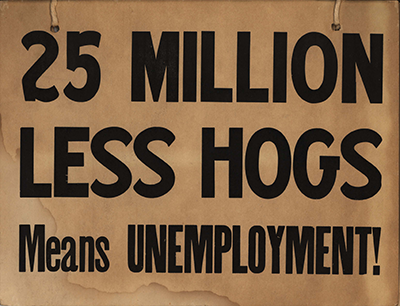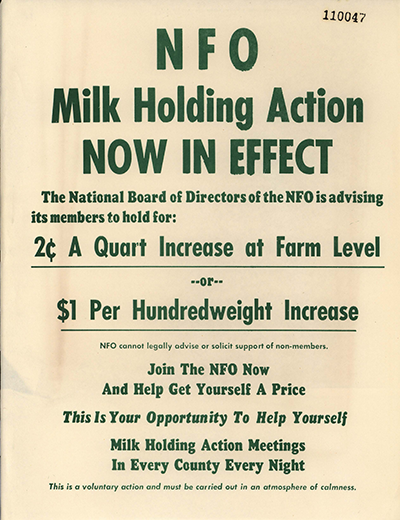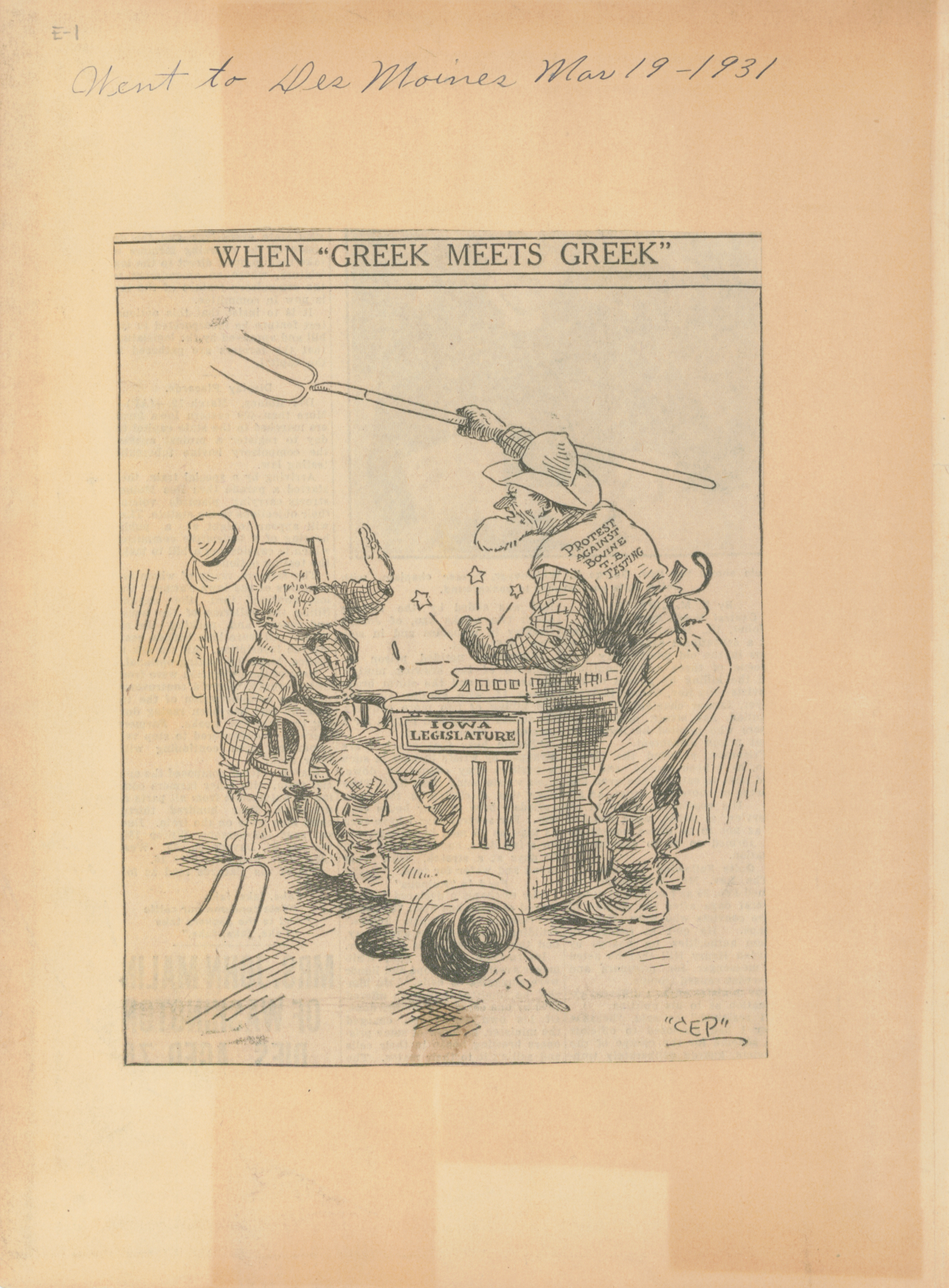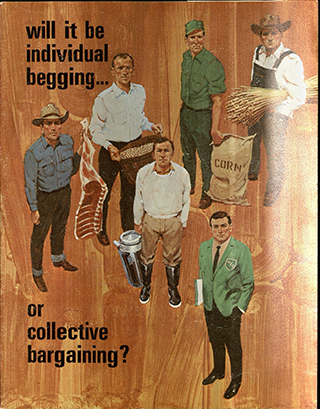How Did They Do It?
 Picket sign from the Iowa Farmers Union, ca. 1953. Artifact 2008-268.003, Iowa State University Library Special Collections and University Archives.
Picket sign from the Iowa Farmers Union, ca. 1953. Artifact 2008-268.003, Iowa State University Library Special Collections and University Archives.
Strikes and Protests
A recurring approach was the demonstration or march. The 1932 blockade of Sioux City during the Farmers' Holiday movement is one of the most striking examples. 1500 or so farmers successfully blockaded the roads into the city in an effort to withhold goods from market for almost a month.1 During the Cow War, thousands of farmers marched into the legislature in Des Moines to insist that the bovine tuberculosis tests requirement be overturned. Later in the 1950s, farmers demonstrated against agricultural legislation they felt to be unfair while carrying placards, such as the one shown here from the Iowa Farmers Union, conveying their anger and outrage.
 Flyer stating "NFO Milk Holding Action is Now in Effect." National Farmers Organization Records, MS 481, Iowa State University Library Special Collections and University Archives. http://findingaids.lib.iastate.edu/spcl/manuscripts/MS481.html.
Flyer stating "NFO Milk Holding Action is Now in Effect." National Farmers Organization Records, MS 481, Iowa State University Library Special Collections and University Archives. http://findingaids.lib.iastate.edu/spcl/manuscripts/MS481.html.Withholding Actions
Since farmers are the producers of agricultural materials, National Farmers Organization (NFO) used organized holding actions to provide leverage to collective bargaining efforts. In addition to dumping milk and withholding other agricultural products, NFO also held hog shoots in 1968. Slaughtered animals were dumped in trenches and buried. These attention-grabbing actions were controversial even amongst NFO supporters.
 This image was inspired by a protest against bovine testing at the State Capital, but touches on some of the intimidation tactics used to prevent veterinarians from testing cattle on the farms. Political cartoon, "When 'Greek Meets Greek," 1931. George J. Ormsby Papers, MS 109, Iowa State University Library Special Collections and University Archives. http://findingaids.lib.iastate.edu/spcl/manuscripts/MS109.html.
This image was inspired by a protest against bovine testing at the State Capital, but touches on some of the intimidation tactics used to prevent veterinarians from testing cattle on the farms. Political cartoon, "When 'Greek Meets Greek," 1931. George J. Ormsby Papers, MS 109, Iowa State University Library Special Collections and University Archives. http://findingaids.lib.iastate.edu/spcl/manuscripts/MS109.html.
Violence, Threats, and Intimidation
The Farmers Holiday movement was unusually heated, resulting in several assaults, injuries (both deputies and strikers were injured) and a death from accidental discharge.2 A particularly noteworthy example is the abduction of Judge Charles C. Bradley who was taken from his courtroom by a group of over 600 protestors. He was blindfolded, assaulted, and partially choked.3

Other Methods
Media
In other instances, farmers and farm groups used the news media as a platform to communicate their discontent to a broad audience. Editorials captured the farmers' grievances and political cartoons visually summed up the feelings of a particular moment.
Collective Bargaining
Farmers organizations such as the Iowa Farmers Union (IFU) and the NFO took a page from organized labor movements. The IFU created guides such as the Organizers Manual to guide its leaders in organizing and recruiting for the organization. In 1957, John Lane as head of the NFO traveled to Detroit to seek funding and advice from famed labor organizer Walter Reuther of the United Auto Workers.4 Later on, NFO championed collective bargaining between organized farmers and food processors to set fair prices on raw agricultural products.
Political Engagements
Finally, farmers took to political careers as means to enact change. For example, Al Loveland drew on his experience as a farmer in his campaign for the U.S. Senate in 1950. Whereas other methods of protest sought to effect change for farmers from outside of the legislative structure, Loveland sought to work within the political structure as a means of advocating for the needs of farmers.
- 1. Verlyn Klinkenborg, “The Conscience of Place: Highway 75, Iowa,” Mother Jones(blog), accessed June 22, 2018, https://www.motherjones.com/politics/2001/03/conscience-place-highway-75-iowa/.
- 2. Jason LeMaster, “Farmers’ Holiday Strike of 1932,” Historical Society of Pottawattamie Count, undated, http://www.thehistoricalsociety.org/history-online/farmers-holiday-1932-strike.html.
- 3. Special to the New York Times, “Iowa Farmers Abduct Judge From Court, Beat Him and Put Rope Around His Neck,” New York Times, April 28, 1933, sec. 1, page 1.
- 4. John Lauck, American Agriculture and the Problem of Monopoly: The Political Economy of Grain Belt Farming, 1953-1980 (Lincoln, NE: University of Nebraska Press, 2000).